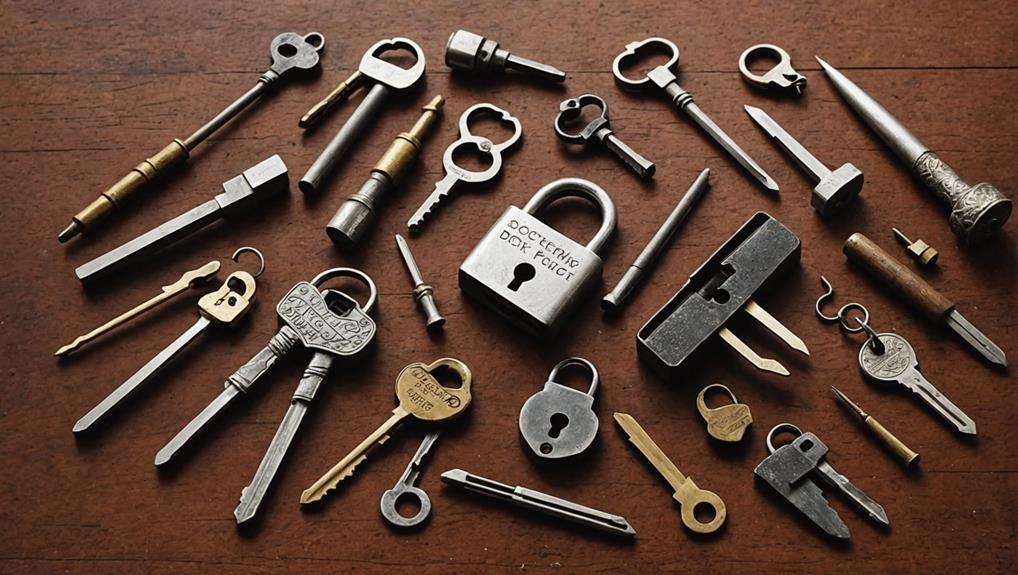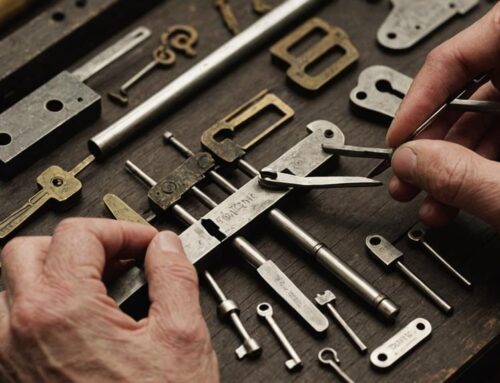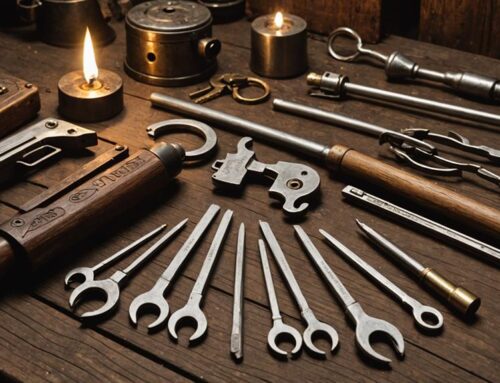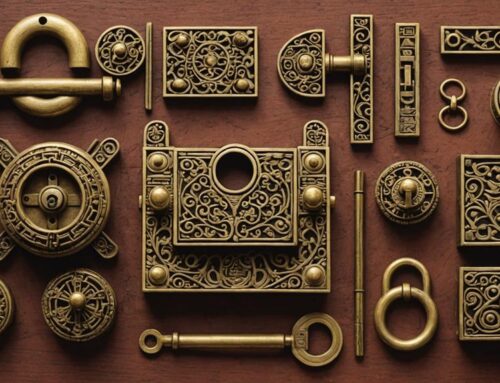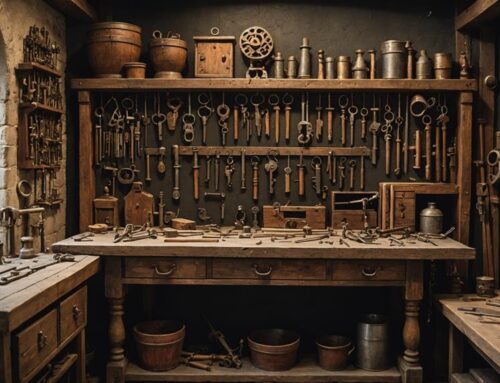Explore the fascinating journey of lock picking evolution, starting with the intricate mechanisms of ancient artisans using wood, metal, and bone for security. Egyptian pin tumblers introduced precise key alignment, setting the stage for modern locks. Roman lever mechanisms elevated security, with lever lifting opening doors. Warded locks simplified designs, making picking easier. 18th-century escutcheons added layers of security. Industrial revolution innovations brought advanced lever tumblers. Victorian era saw slimline picks and high-quality steel tools. The 20th century introduced specialized picks and materials for complex locks. Modern electronic bypasses highlight the continuous adaptation to technology for enhanced security.
Key Takeaways
- Ancient locks featured intricate mechanisms crafted from durable materials like metal and bone.
- Egyptian pin tumblers introduced precise key alignment, laying the foundation for modern lock designs.
- Roman lever mechanisms utilized hooks and picks for manipulation, influencing future locksmithing practices.
- Medieval warded locks used obstructions and skeleton keys, driving advancements in lock picking techniques.
- 18th-century escutcheons enhanced lock complexity, reflecting the ongoing evolution of security features.
Ancient Locks and Tools
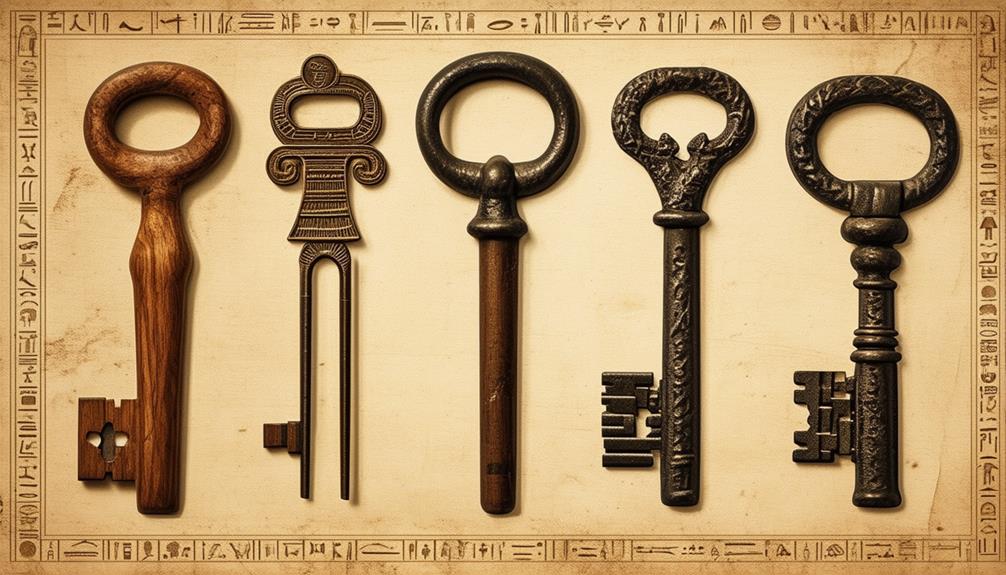
Ancient locks and tools have long fascinated historians and locksmiths alike. Imagine the intricate mechanisms of ancient locks crafted by skilled artisans. These locks, made of wood, metal, and sometimes even bone, were designed to protect valuables and secure doors in ancient civilizations.
The techniques used to understand and manipulate these locks included various methods that highlighted the ingenuity of their creators, showcasing top techniques for manipulation. The tools used by locksmiths of the past were simple yet effective, consisting of picks, tension wrenches, and other specialized instruments crafted with precision.
Studying ancient locks and tools provides invaluable insight into the craftsmanship and ingenuity of our ancestors. By understanding how these early locking mechanisms worked, modern locksmiths can appreciate the evolution of their craft and the principles that still apply today.
The use of tools like picks and tension wrenches has remained consistent throughout history, showcasing the timeless effectiveness of these techniques.
Exploring the history of ancient locks and tools allows us to appreciate the foundations upon which modern locksmithing practices are built. By delving into the intricacies of these early mechanisms, we gain a deeper understanding of the art and science of lock picking.
Egyptian Pin Tumblers

The craftsmanship of early locksmiths extends beyond mere functionality, showcasing a level of sophistication that continues to intrigue modern experts.
Egyptian pin tumblers, dating back to ancient times, were a significant advancement in the evolution of lock picking. These early locks consisted of wooden pins of varying lengths, requiring a specific key to align them perfectly for the lock to open. This ingenious design reflects the tools used throughout the centuries that have influenced modern security practices. The concept of pin tumblers in ancient Egypt laid the foundation for modern lock mechanisms that are still in use today.
Understanding the intricate design of Egyptian pin tumbler locks sheds light on the evolution of lock picking techniques from ancient to modern times.
By manipulating the pins within the lock, locksmiths in antiquity were able to release doors and chests. This early innovation paved the way for the development of more sophisticated locking systems that are prevalent in contemporary security mechanisms.
Studying the ancient Egyptian approach to pin tumblers provides valuable insights into the origins of lock picking methods that have continued to evolve over the centuries.
Roman Lever Mechanisms
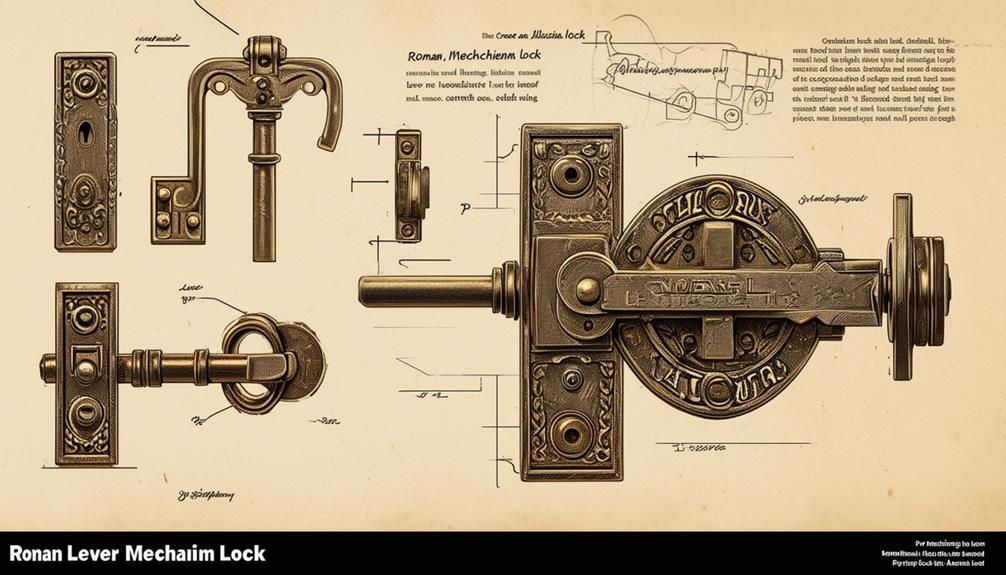
Let's explore the fascinating world of Roman Lever Mechanisms.
These early lock mechanisms utilized lever systems that required specific tools for manipulation, such as hooks and picks designed to interact with the levers within the lock.
Understanding the tools and techniques used by Roman locksmiths sheds light on the foundation of lock picking practices, illustrating how medieval locksmith tools evolved from these ancient innovations.
Early Lock Mechanisms
During the Roman era, individuals sought innovative ways to secure their belongings, leading to the development of lever mechanisms in early locks. These mechanisms were essential in advancing the security of valuables and deterring unauthorized access. Understanding the basics of early lock mechanisms can provide insight into the evolution of lock picking techniques.
—
| Lever Mechanisms in Early Locks | ||
|---|---|---|
| Description | Function | Advantages |
| Consisted of a set of levers that had to be lifted to specific heights | Prevented the bolt from moving in the lock | Provided a higher level of security compared to previous simple lock designs |
| Operated by inserting a key to lift the levers to the correct positions | Required precise manipulation for successful release | Made it more challenging for unauthorized individuals to pick the lock |
| Each lever needed to be lifted to a precise height simultaneously | Created a complex system that required skill and knowledge to bypass | Increased the complexity of the lock, making it harder to pick |
Roman Locksmith Tools
To understand Roman locksmith tools, particularly the lever mechanisms they utilized, it's vital to explore the practical applications of these tools in securing valuable possessions.
Roman lever mechanisms were historical lock picking innovations that played a significant role in safeguarding homes, temples, and other important structures during ancient times. These tools consisted of intricately designed levers that needed to be lifted to specific heights to align and release the locking mechanism.
Roman locksmiths were skilled artisans who crafted these tools with precision, using materials like iron and bronze. The lever mechanisms were inserted into keyholes to manipulate the internal components of the lock, allowing entry to authorized individuals.
These historical lock picking innovations highlight the advanced engineering capabilities of the Romans and their dedication to protecting their belongings.
Medieval Warded Locks
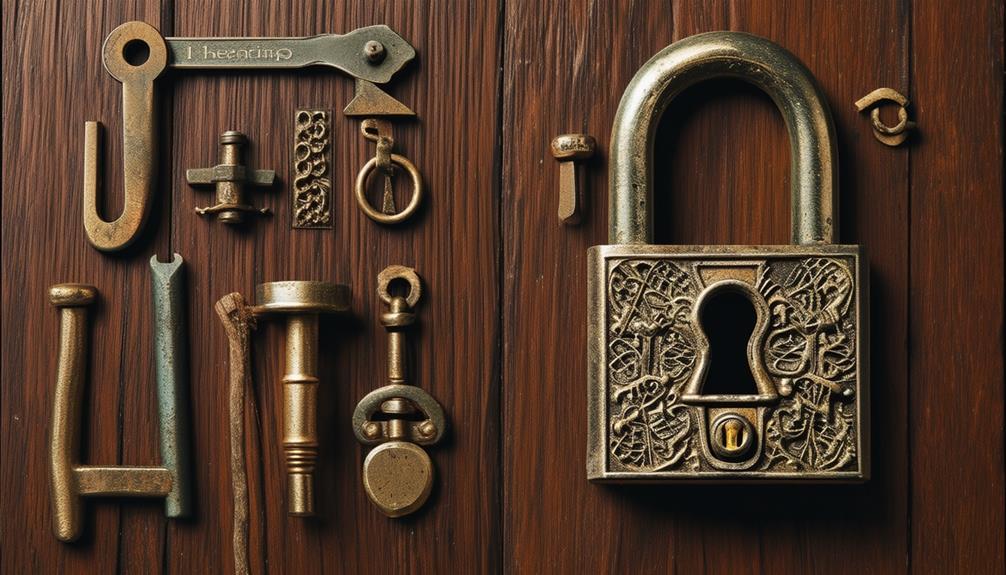
Exploring the intricate mechanisms of medieval warded locks provides insight into the ingenuity of locksmiths during that era. These locks, prevalent in medieval Europe, operated using a set of obstructions or wards within the lock casing. A key with corresponding notches would bypass these wards, allowing the lock to turn and open.
Unlike modern pin tumbler locks, warded locks were simpler in design but still effective in securing valuables. This simplicity made them easier to pick, leading to a fascinating interplay between security and the art of gaining access to history.
Lock picking during this period evolved as locksmiths and thieves devised new tools and techniques. Skilled lock pickers would fashion skeleton keys, flat metal devices with a series of ridges, to manipulate the wards inside the lock. By carefully maneuvering the key within the keyway, these individuals could bypass the wards and release the mechanism.
While warded locks offered a level of security, their vulnerabilities led to the development of more sophisticated lock designs in later centuries. Understanding the evolution of lock picking through medieval warded locks sheds light on the constant battle between locksmiths and those attempting to circumvent security measures.
18th-Century Escutcheons
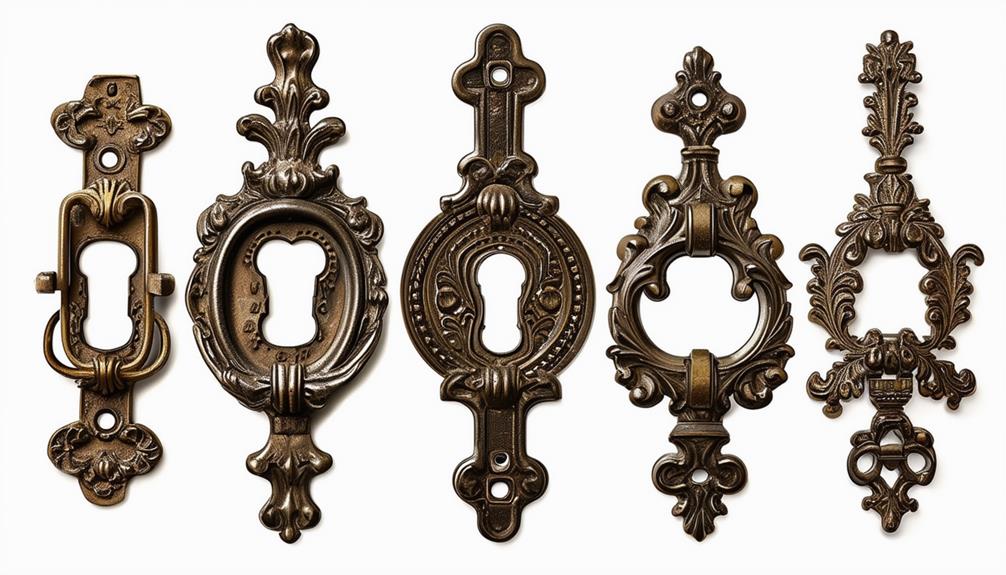
The evolution of lock mechanisms in the 17th century saw the rise of intricate designs known as escutcheons. These were decorative plates surrounding keyholes on doors, chests, and cabinets. However, they weren't just ornamental. Escutcheons played a crucial role in lockpicking advancements by adding an extra layer of complexity to the locking mechanisms, making it more challenging for unauthorized access.
To understand the significance of escutcheons in lockpicking advancements, let's explore a comparison of different lock features in the 17th century:
| Lock Feature | Description | Impact |
|---|---|---|
| Escutcheons | Decorative plates around keyholes | Added complexity to lock mechanisms |
| Warded Mechanisms | Obstructive internal wards | Hindered direct access to pins or levers |
| Key Shape Variation | Unique designs for different locks | Required specific tools for each lock |
| Intricate Keyways | Complex pathways for keys | Demanded precision in picking techniques |
| Multi-Layered Security | Combination of features for heightened protection | Challenged locksmiths with diverse obstacles |
Industrial Revolution Innovations

During the Industrial Revolution, locksmiths and inventors revolutionized lock picking through the introduction of mechanical innovations that transformed the security landscape.
These advancements paved the way for more sophisticated methods of breaching locks, further highlighting the need for enhanced protection against unauthorized access as seen in modern high-security locks.
Here are four key innovations from this period:
- The Lever Tumbler Lock: This type of lock, with its unique set of levers that must be lifted to specific heights to release, provided a higher level of security than previous designs.
- Jeremiah Chubb's Detector Lock: Chubb's invention featured a mechanism that would immobilize the lock if someone attempted to pick it, making it extremely difficult to bypass.
- Joseph Bramah's "Unpickable" Lock: Bramah's lock design was touted as unpickable due to its intricate mechanism, challenging even the most skilled lock pickers.
- The Pin Tumbler Lock: Developed by Linus Yale Sr., this lock design utilized pins of varying lengths to prevent the lock from turning without the correct key, setting the foundation for modern pin tumbler locks.
These innovations during the Industrial Revolution marked a significant shift in lockpicking history, leading to more secure locking mechanisms and inspiring further developments in the field.
Victorian Era Picks
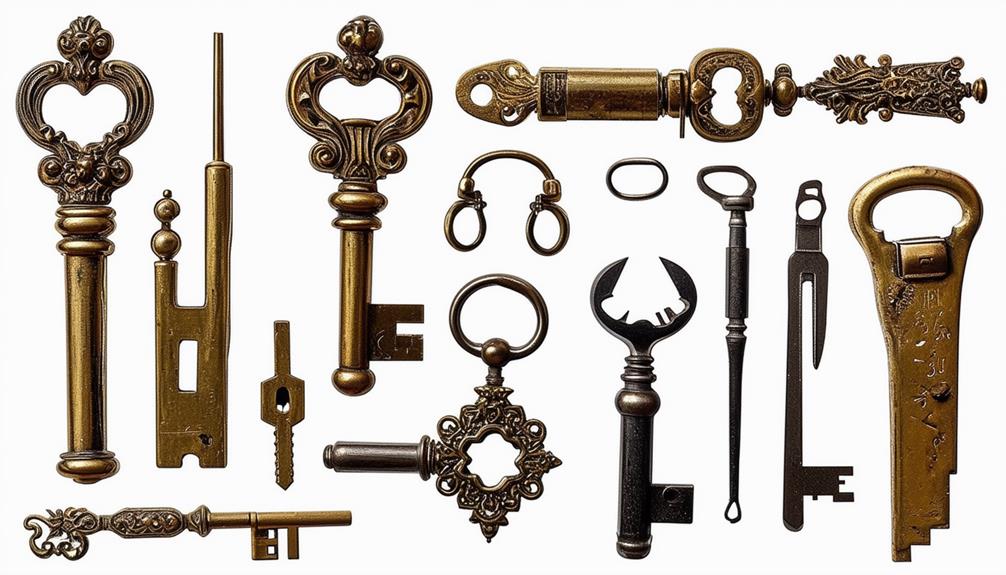
Innovations in lock picking continued to evolve during the Victorian Era, with locksmiths and enthusiasts exploring new techniques and tools to bypass increasingly complex locks. The rise of industrialization during this time also led to the creation of more sophisticated locking mechanisms, prompting a corresponding advancement in picking tools and methods.
Victorian era picks were crafted with precision and ingenuity to tackle the sophisticated mechanisms found in locks of that time. Lock pickers during this era experimented with various shapes and sizes of picks to better manipulate the intricate wards and levers inside locks.
One notable advancement was the development of slimline picks, which allowed locksmiths to navigate tight spaces within the lock more effectively. These picks were often made of high-quality steel and meticulously shaped to fit specific keyways. Additionally, tension tools became more specialized, offering locksmiths better control over the turning of the lock's cylinder while picking.
For those interested in mastering these techniques, the importance of understanding advanced lock picking methods can't be overstated.
Victorian era picks marked a significant leap in the evolution of lock picking tools, setting the stage for further advancements in the field. The attention to detail and craftsmanship put into these picks reflected the dedication of locksmiths to master their craft and overcome the challenges posed by intricate Victorian locks.
20th-Century Locksmith Tools
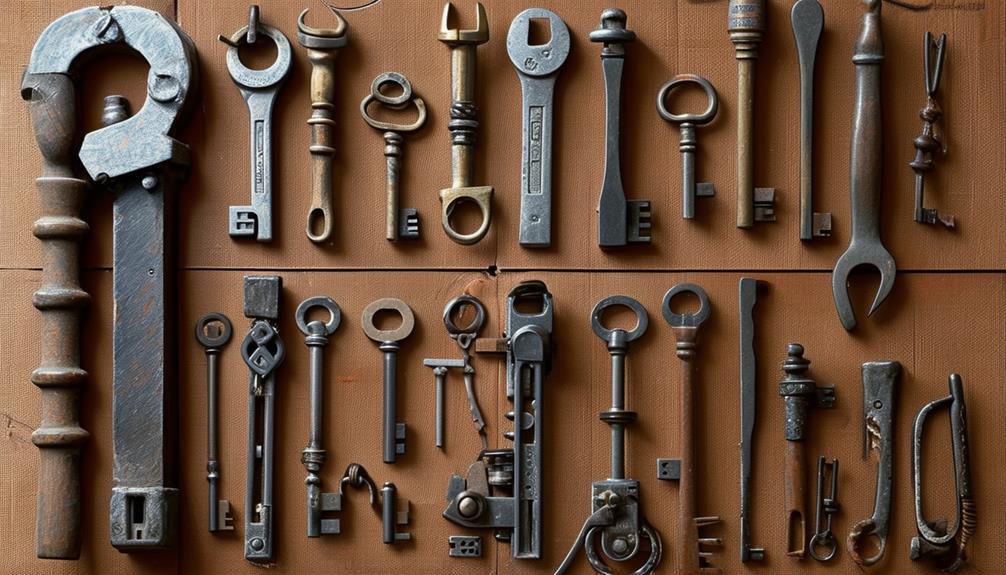
As locksmithing progressed into the 19th century, locksmith tools underwent significant transformations to meet the demands of increasingly intricate lock mechanisms.
The evolution of these tools was influenced by advancements in lock design and the growing complexity of security systems, prompting locksmiths to refine their techniques and tools.
Historic locksmithing tools from this era reflect the craftsmanship and ingenuity of locksmiths faced with evolving security challenges, showcasing methods that would eventually lead to mastering advanced lock picking techniques.
Here are four key features of 19th-century locksmith tools:
- Specialized Picks: Locksmiths crafted picks with more precision and variety to navigate the complex mechanisms of newer locks.
- Improved Key Extractors: With the advent of more sophisticated locks, locksmiths developed enhanced key extractors to aid in the removal of broken keys.
- Innovative Turning Tools: Locksmiths designed turning tools that allowed for more nuanced movements within the lock, enhancing control and manipulation.
- Sturdier Materials: To withstand the pressures of intricate lock mechanisms, locksmiths started using stronger materials like tempered steel to create durable tools.
The 19th-century saw a significant shift in locksmith tool design, marking a pivotal moment in the history of lock picking and security technology.
Modern Electronic Bypasses

Locksmithing tools have continuously evolved to keep pace with advancements in security technology. In the domain of lockpicking technology, modern electronic bypasses have become increasingly prevalent. These electronic bypasses involve using specialized tools that can manipulate electronic components within a lock, such as sensors or actuators, to gain unauthorized access.
One common method involves exploiting vulnerabilities in keyless entry systems, where hackers can intercept and replicate signals to gain entry without detection. The rise of digital keyless locks provides both convenience and potential vulnerabilities, making it essential to understand their security implications.
Additionally, some electronic locks can be vulnerable to techniques like bumping or using electromagnetic tools to manipulate the internal components and release the locking mechanism.
Biometric locks, which use fingerprint or retinal scans for access, have also been targeted by sophisticated hackers who can create fake biometric data to fool the system.
As technology advances, so do the methods used by both locksmiths and malicious actors. Understanding these modern electronic bypasses is vital for maintaining the security of electronic locking systems and staying ahead of potential threats.
Frequently Asked Questions
How Did Lock Picking Become Associated With Criminal Activity?
Lock picking became linked to crime due to its illicit use in bypassing security.
Criminals saw the potential to gain unauthorized access by picking locks. This misuse of lock picking techniques led to its association with illegal activities.
As a result, the skill gained a negative reputation, even though it originally served a legitimate purpose in locksmithing and security testing.
Misuse by criminals tarnished its image and led to its criminal association.
Are There Any Famous Historical Figures Known for Lock Picking?
Yes, there are famous historical figures known for lock picking. Notable individuals like Harry Houdini and the Great Escapist, Houdini, were renowned for their lock picking skills.
Their abilities to escape from handcuffs, shackles, and locked containers captivated audiences worldwide. These figures elevated lock picking from a mere practical skill to a form of entertainment and challenge.
Their talents and showmanship helped popularize the art of lock picking.
Were There Any Lock Picking Competitions in History?
In history, lock picking competitions weren't commonly documented, but skilled locksmiths and thieves often showcased their abilities in friendly challenges.
These contests typically involved speed and precision in opening various types of locks. While not as formal as modern competitions, these events were a way for individuals to demonstrate their prowess and exchange techniques.
Lock picking was both a practical skill and a form of entertainment, showcasing dexterity and knowledge of mechanisms.
What Are Some Common Misconceptions About Lock Picking?
Some common misconceptions about lock picking include the belief that it's only used for illegal activities.
In reality, lock picking is a valuable skill for locksmiths and security professionals.
Another misconception is that all locks are easily picked. However, high-quality locks can be quite challenging to open without the proper tools and expertise.
Additionally, some people think lock picking requires brute force, but it's actually a delicate and precise technique.
How Has the Portrayal of Lock Picking in Media Evolved Over Time?
So, you know how in the old days, lock picking was portrayed as this shady, mysterious skill only the bad guys had?
Well, now, thanks to Hollywood glamour, it's all sexy spies and tech-savvy hackers popping locks with a flick of their wrist.
The evolution of lock picking in media reflects society's fascination with technology and espionage, turning a once taboo practice into a cool, almost heroic act.
Conclusion
As you reflect on the historical innovations in lock picking, remember that every twist of the tumbler and turn of the pick represents a journey through time. From the ancient Egyptian pin tumblers to modern electronic bypasses, each advancement in technique has shaped the art of locksmithing. So next time you pick a lock, think about the centuries of innovation that have brought us to where we are today. Lock picking isn't just a skill – it's a connection to our past.

